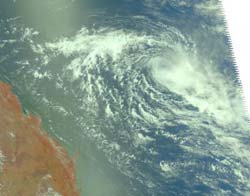NASA's Aqua Satellite sees Tropical Depression Anthony heading toward Australia

NASA\'s Aqua Satellite captured this visible image on Jan. 26 at 03:23 UTC of a now weakened Tropical Depression Anthony as it continues to weaken in the South Pacific Ocean. Eastern Australia can be seen on the left side of this image. Credit: NASA JPL, Ed Olsen<br>
The Atmospheric Infrared Sounder (AIRS) instrument that flies aboard NASA's Aqua satellite captured a visible image on Jan. 26 at 03:23 UTC of Tropical Depression Anthony in the South Pacific Ocean. The image revealed a cloud-filled center of the storm.
At 0600 UTC (1 a.m. EST) on January 26, Anthony had progressed west and was now about 455 nautical miles west-northwest of Nomeau, New Caledonia. That places Anthony's center near 19.2 South and 159.1 East. Maximum sustained surface winds are estimated at 25 to 30 knots (28 mph/46 km/hr to 34 mph/55 km/hr) meaning that Anthony is still at tropical depression status.
The infrared imagery from the AIRS instrument showed a well-defined low level circulation center, although dry air is now wrapping into Anthony's northern quadrant. Dry air saps the moisture that creates the thunderstorms that power a tropical cyclone. Generally, the storm's convection (rapidly rising air that creates those thunderstorms) is weak throughout the storm, and only isolated strong areas of convection appear in the southeastern quadrant. That may change in the next day or two, however, as Anthony moves into an area more conducive to maintaining a tropical cyclone.
Vertical wind shear (winds that can weaken a tropical cyclone) has lessened and sea surface temperatures are warm enough to sustain and strengthen a tropical cyclone (between 28 and 30 Celsius/82 and 86 Fahrenheit). Computer forecast models have shown forecasters at the Joint Typhoon Warning Center that as the system tracks westward toward Australia, there is a fair chance that Anthony will regenerate or re-strengthen in the next 24-36 hours. Forecasters in Queensland, Australia will be watching Anthony very closely.
NASA's Hurricane page: www.nasa.gov/hurricane
Media Contact
All latest news from the category: Earth Sciences
Earth Sciences (also referred to as Geosciences), which deals with basic issues surrounding our planet, plays a vital role in the area of energy and raw materials supply.
Earth Sciences comprises subjects such as geology, geography, geological informatics, paleontology, mineralogy, petrography, crystallography, geophysics, geodesy, glaciology, cartography, photogrammetry, meteorology and seismology, early-warning systems, earthquake research and polar research.
Newest articles

“Nanostitches” enable lighter and tougher composite materials
In research that may lead to next-generation airplanes and spacecraft, MIT engineers used carbon nanotubes to prevent cracking in multilayered composites. To save on fuel and reduce aircraft emissions, engineers…

Trash to treasure
Researchers turn metal waste into catalyst for hydrogen. Scientists have found a way to transform metal waste into a highly efficient catalyst to make hydrogen from water, a discovery that…

Real-time detection of infectious disease viruses
… by searching for molecular fingerprinting. A research team consisting of Professor Kyoung-Duck Park and Taeyoung Moon and Huitae Joo, PhD candidates, from the Department of Physics at Pohang University…




















